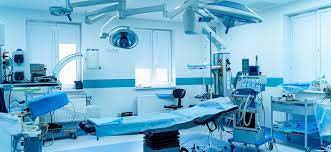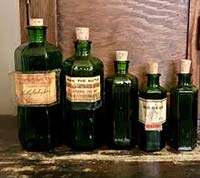Thursday, 25 January 2024

Murderous Anaesthetists
Speaker: Alan Kershaw
The guest speaker at the u3a Todmorden Members Meeting on the 18 January was Alan Kershaw, who presented 'Murderous Anaesthetists'. Alan retired from a career in Anaesthesia in 2017, having worked in South Yorkshire for 25 years.
He began by reminding us that practicing medicine is a dangerous business, as is anaesthesia. He said that death, and the methods of trying to prevent illnesses and injury leading to death, were accepted as part of human life up until around the eighteenth century.

Anaesthesia has been, and possibly still is, regarded as a 'dark art'. He mentioned 'green for danger', as an early example of how a patient might be killed. In the early years of surgery while the patient is asleep, oxygen was used, as it is today. The oxygen came from green coloured cylinders. More than one patient died after receiving a noxious gas from a 'substituted' cylinder. Alan then took us through his list of cases, and incidents of malpractice and murder over the years, in Britain and abroad.
In 1807, a man called John Williamson worked, without any sort of training or qualification, as a male midwife, delivering a number of babies in the East End of London. One day, after leaving a mother and new child, he was called back as she had started to bleed again. His subsequent 'treatment' resulted in a massive loss of blood and the woman died. He was tried for murder, but found not guilty after the trial judge directed the jury that, to find guilt in manslaughter 'the prisoner must have been guilty of the grossest ignorance or the most criminal inattention'. This standard of proof was held for many years afterwards, as did one of the lines in the Hippocratic Oath - Primum non nocere, or 'First do no harm'
 Alan told us that drugs used for anaesthesia are also used for drug abuse, examples being Ether and Nitrous Oxide. In the 1950s, American Dr William Ray, became addicted to Halothane, and pleaded guilty to manslaughter, after a patient he was operating on died while he was 'high'. He escaped with a suspended sentence.
Alan told us that drugs used for anaesthesia are also used for drug abuse, examples being Ether and Nitrous Oxide. In the 1950s, American Dr William Ray, became addicted to Halothane, and pleaded guilty to manslaughter, after a patient he was operating on died while he was 'high'. He escaped with a suspended sentence.
Nearer home, at a hospital in London in the 1970s, the people connecting up supplies of Oxygen and Nitrous Oxide to an operating theatre, got their 'lefts' and 'rights' mixed up. Extra oxygen would be needed for patients who experienced breathing problems, and Nitrous oxide is for pain relief. Two patients died before the connection mistakes were discovered.
In 1990, anaesthetist Dr John Adomako was convicted of manslaughter at the Old Bailey after the death of a patient from cerebral hypoxia, which is a lack of blood getting to the brain, three years earlier. He was, however, acquitted of two counts of perjury relating to evidence given by him in the Coroner's Court, where he denied leaving the patient unattended in the operating theatre while he went to get himself a coffee and switching off the alarms on the ventilator.
Another case involved a doctor known personally by Alan. It involved the ventilator which was used in an operation. The doctor chose the wrong delivery method to deliver oxygen to the patient, resulting in many times the safe amount, causing the patient to literally explode. The doctor was convicted of manslaughter.
An anaesthetist called Dr Gadgil was jailed for six months after he admitted killing a teenager who was given laughing gas, rather than oxygen, to have a milk tooth removed. Around the time of the incident, it was not unusual for anaesthetists to work in dental surgeries. The investigation that followed revealed a number of failings in the equipment, and other aspects concerning the dental practice. It was also discovered that other people, mainly children, had died during this sort of procedure, at a rate of 12 each year. Dr Gadgil pleaded guilty to manslaughter at Sheffield Crown Court. The dentist concerned walked free from any charges.
Alan told us that around this time, deaths of patients began to be viewed more seriously by the police, which led to suspensions of registrars and other senior doctors during investigations.
In February 2021, a patient died during surgery at the hospital on the Isle of Man, leading to four anaesthetists being charged with manslaughter through negligence. No other operations could be carried out on the island for at least a year because of this, and there were no convictions in the end.
Police in America attended what was reported as a sudden death. A young woman died after a cardiac event. One of the officers attending noticed what looked like in injection mark on her body and decided to check around the property where she died. Outside the house was a plastic container which had contained six ampoules of Propofol, a sedative drug. They traced a serial number on the container, and the manufacturers were able to say which hospital the drugs had been sent to. The hospital had recorded which employee had been issued with them – an RTU, or Rapid Treatment Nurse, called Oliver O'Quinn. He was convicted of murder and is serving a life sentence.
Alan showed us a picture and asked who, if any of us, could identify the man who had been on our TV screens almost nightly some years ago. No one could remember. It was Dr Conrad Murray, the man who became known after the death of Michael Jackson in 2009. Although he had no qualifications to do so, he anaesthetised the singer each night, again with Profofol. It was found that he had been doing this for two weeks, and it was in the third week that the singer died. Dr Murray was convicted of manslaughter. He was released after two years of a four year sentence, and can still practice medicine.
The list of medical malpractice continued with accounts of false data and research, carrying out surgery while drunk, and practicing treatment and procedures with no qualifications, which is thought to have been a factor in at least five deaths.
Alan ended with an unusual example from Hong Kong: an anaesthetist who caused the death of his wife and daughter. He filled a yoga ball with anaesthetic, then put it in the boot of their car, and making a hole in the ball. He intended just to kill his wife, but saw his daughter get into the car just before they drove off. He did nothing to stop them and prevent the collision which led to both their deaths. A police investigation followed, along with a trial, and life sentence, for the husband and father.
After the descriptions, accounts and explanations in his presentation, Alan reassured us that although the cases he had described are memorable, surgery and anaesthesia is practiced safely, in our country at least. Investigation techniques have improved as years have passed, for example if an illegal drug had been used during an operation resulting in the death of a patient, traces of it will be detected in their hair.
After a well-earned round of applause for his presentation, Alan stayed to answer many, and varied, questions from our members for almost another twenty minutes. This resulted in a great start to u3a Todmorden Members Meetings for 2024, and a memorable afternoon for our final meeting in the Central Methodists Hall.
Not yet a member? We're always delighted to welcome new members. Contact details: website at www.u3atod.org.uk or email at info@u3atod.org.uk.
Many thanks to Colin Sanson for this report
Previous U3A reports on the HebWeb - click here

